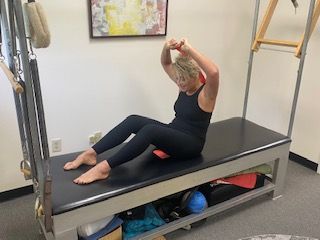Unlike Yoga which is an ancient system that incorporates physical, mental and spiritual disciplines and Tai Chi, which is also an ancient practice, Pilates was a man. Joseph Hubertus Pilates was a revolutionary figure in the fitness industry. Mr. Pilates began to develop his system of exercise in 1912, which he himself called Contrology. The name says a lot. He created the original 34 mat exercises we still practice today and was one of the first to use outcome studies and photography to document the benefits of his method. His teachings included developing abdominal strength and control over one’s body. He later created his apparatus such as the Reformer, Cadillac, Wunda Chair, Ladder Barrel and other lessor known pieces. Well over a hundred years later this system now simply called Pilates promotes core stability, increased balance, overall flexibility, postural awareness, correction of muscle imbalances and endurance. Joe himself worked with several hypermobile bodies in his New York City studio, specifically dancers and contortionists. Thankfully, due to the way he recorded his work, authentic Pilates instructors can see how he individualized the system to every one of his students. The benefits were game changing then just as they still are today. You will not find this testimony from a group yoga or Tai Chi class. Although these systems will help with centering, proprioception, lowering blood pressure, helping to combat sleep disorders and aiding one with anxiety which can be beneficial for many people regardless of hypermobility we must look at the downside. Increasing flexibility to the degree performed in both yoga and Tai Chi will wear down the flimsy tendons and ligaments in an EDS body. The connective tissue disorder from faulty collagen production requires a more specific regime because stretching may feel great at first, but it won’t for long. The poses held in a traditional yoga class may not dislocate your wrist, it could do worst. A 90-minute class could result in a hypermobile person experiencing such severe pain and discomfort that they become bed ridden for weeks.
With that said, there are lots of exercise clothes that come in ‘one size fits most’ but exercises need to be designed for the individual and fit the body perfectly. Pilates replaces poses with small micro movements that are performed to develop a strong powerhouse as Joe called the core of the body for each student. That doesn’t mean every Pilates student should do the same exercises. Our goal is to create a body in balance which as a result will help prevent injuries. This is crucial for everyone with EDS regardless of what type. Achieving it means being mindful of who you are working on. As I worked with more clients dealing with Ehlers-Danlos Syndrome I realized they need to learn to exercise efficiently and effectively for their individual bodies needs, learning how to stabilize and control their flexibility with movements designed for their unique requirements. Pilates corrects postural imbalances and helps to develop better body awareness more than any other method of exercise when presented correctly. This is important for everyone including those with and without EDS.
Unlike the one size fits all outfit, Pilates fits everybody if it is made to order. Before anyone begins a Pilates practice, it is important to first find a Certified Pilates instructor who has worked with EDS patients or is at least willing to learn about it. Not everyone knows what EDS is and Pilates has become a generic term. This can be a dangerous combination. There is classical Pilates, the way Joe taught; there is also contemporary Pilates, cardio Pilates, Pilates on the ball, Pilates at the barre, Pilates with suspension systems and lots of Pilates in large groups. Most of it is a low-impact way to work out but that doesn’t mean that its safe. There are also different types of EDS. In the Pilates repertoire there are now over five hundred exercises left to us by Mr. Pilates. Instructors certified in the system need to know which ones are best for each client and what modifications may need to be presented for that body.
I had another EDS client who would repeatedly try to coax me into stretching her after a session. It would have been a release for only a very short time and then she would have experienced severe pain. I would have to refuse. I also had to eliminate the pull pull from an exercise known as single straight leg stretch in the abdominal five series. Tree from the short box series was another exercise that needed to be removed all together, even though they were favorites of hers. What works for one person dealing with EDS may not be best for another person with the genetic disorder. For clients it’s important to have dialogue with your instructor. For instructors its important to listen and evaluate each client throughout their sessions. They can still progress and can be challenged just like any student of the method. The common denominator, the thing that does work for every one is starting out with the principles that Joe taught and the basic exercises. A strong foundation is something everybody needs regardless of EDS or any mast cell activation disorder or connective disorder. The goal is always the same as well, to live the best quality of life that we all can our bodies and our well being. Pilates is the best prescription.
To learn more visit Mast Cell Advanced Diagnostics


